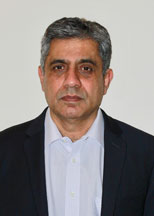Afzal Suleman

Position
Professor
Mechanical Engineering
Contact
Office:
EOW 509
Credentials
Ph.D (UBC), P.Eng
Area of expertise
Fluid - structure interaction of heart valves and disease.
Research Areas
- Computational and Experimental Mechanics
- Multidisciplinary Design Optimization
- Fluid-Structure Interaction
- Active Aeroelastic and Morphing Aircraft Structures
- Aeronautics and Space
- Ocean Energy and Technology
Research Description
Active Aeroelastic and Morphing Aircraft Structures - This project investigates the application of smart materials and structures technology to aeroelasticity problems in aircraft structures. The project aims at improving aircraft performance and efficiency by approaches from completely new design perspectives. Unlike conventional approaches, new control surface concepts are employed to induce twist, causing the wing itself to produce control forces. Potential benefits include improved aerodynamic efficiency due to thinner wing design, increased control power with application of lower control forces, and decreased structural loads. This unique design approach will also allow considerable reduction in structural weight, aerodynamic drag, manufacturing efforts, fuel consumption, and operating costs. This research has resulted in a considerable number of publications in journal and conferences, several aircraft prototypes for flight testing of the active control strategies using smart structures.Multidisciplinary Design Optimization – A multidisciplinary design optimization (MDO) tool, containing aerodynamic, structural analyses and weight prediction information was developed to help design a morphing wing for a light UAV in order to improve and quantify its performance. This embryonic and pioneering research effort has resulted in several pioneering papers in the open literature.
Nonlinear Fluid-Structure Interaction – In this work, a new method was developed to obtain nonlinear aeroelastic solutions in the time domain . Geometrically nonlinear structures were taken into account using the nonlinear corotational structural kinematics. Stable and accurate nonlinear solutions were obtained applying the corotational description and an implicit energy conserving algorithm. The coupling between these theories and solving the Euler fluid flow problem using multiple moving frames allow to overcome restrictions associated with large deformations. Solutions with no fluid mesh deformation or regeneration are obtained while yielding saving in computations and errors associated with mesh regeneration are reduced.
Topology Optimization Using Level Set Theory – The Spectral Level Set Methodology is a new approach to multidisciplinary topology optimization of interfaces. This methodology is an extension of the level set methods, in which the interface is represented as the zero level set of a function. The advantage of the Spectral Level Set Methodology is to define a sufficiently smooth interface using a reduced number of design variables. In this way, the dimension of the design space is significantly decreased.
Smoothed Particle Hydrodynamics – This unique contribution proposes an improved solid boundary treatment formulation for the smoothed particle hydrodynamics (SPH) method to model fluid-structure interaction physics. Benchmark simulations using previously reported boundary treatments can suffer from particle penetration, and may produce results that numerically blow up near solid boundaries. As well, current SPH boundary approaches do not properly treat curved boundaries in complicated flow domains. A new boundary treatment method called the multiple boundary tangent approach is proposed with good agreement with solutions in the literature.
